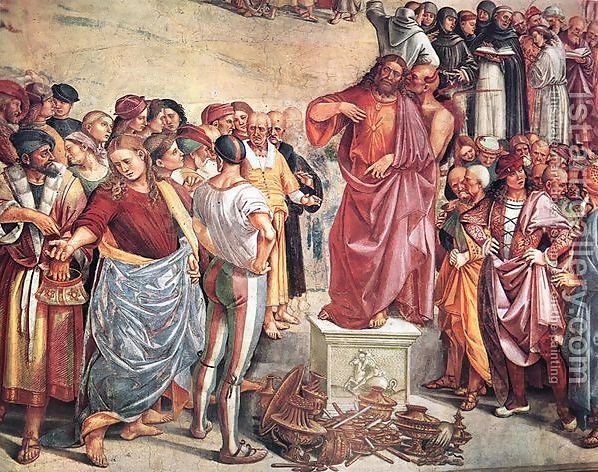
by Bret Capranica | Sep 5, 2013 | Biblical Studies, Eschatology, Featured Articles, Pastoral Ministry, Preaching
For those attending Summit Woods Baptist Church this Sunday, here are a few ways to prepare. Carefully Think Read through Daniel 7. How was the imagery of Daniel’s vision interpreted for him in 7:15-27? Make a list of what you learn? What is God’s role in the events described in this vision? What phrases do you see in Daniel 7 that would give any indication as to the timing of these events? Read Daniel 8 – how does this vision differ from the one in chapter 7 in terms of its interpretation? What does Daniel 10 suggest about the unseen spiritual world and earthly affairs? What does all of the vast detail in the vision of chapters 11 and 12 reveal about God’s sovereignty over the affairs of history and the future? What indication do you see in Chapter 12 that these events are yet future? Prayerfully Meditate What effect should the kind of detail about historical and future events, like those described in Daniel 7-12, have on your view of God? Your choices? Your anxieties? Your confidence? How should Daniel’s description about the world’s future impact how we view what is happening in our culture now? What would a God-centered response to our own cultural changes be in light of what we read in Daniel? How could Daniel’s prayer in chapter 9 assist you in your own approach to confessing sin? How could Daniel’s prophecy as a whole assist you in praying about the coming of Christ? Intentionally Act Pray for Christ’s soon coming. How would he find you if the events of his coming were to begin...

by Bret Capranica | Aug 29, 2013 | Biblical Studies, Eschatology, Expositions, Featured Articles, Pastoral Ministry, Preaching
How do you prepare yourself during the week to engage with God and participate in corporate worship on Sunday? Every week our church gives a number of ways to interact with the passage to be preached, and lists the songs that will be sung, in order to help our congregation be better prepared. These posts will also begin to populate THE CAPRANICA each Thursday. Carefully Think Read Daniel 1:1; 2:1; 5:1, 30, 31; 6:1; and 10:1. Where is Daniel? How many kings does he interact with? Read Daniel 1:1-20; 2:26-28; 6:1-10. Why is Daniel where he is and how would you characterize his character? Glance through the headings in your Bible of Daniel 1-6. Make a list of the sort of events recorded about his life. Glance through the headings in your bible for Daniel 7-12. What are these chapters primarily about? Read 12:5-13. What era of human history is being described in these events and when will they be completed? Read Daniel 2:20-23; 4:2-3, 34-35; 6:25-27; 7:9-10, 13-14. What is emphasized about God in these chapters? Prayerfully Meditate What do you learn about Daniel, his friends and what commitment to God looks like in the midst of opposition? Have you every experienced opposition from those outside of Christianity to your faith? When? How? How would Daniel be a helpful example to you? How could Daniel’s overt, God-centered life-style instruct you and how you conduct yourself at work, in your neighborhood, or in our culture generally? Read Daniel 9:1-19. How could this be a helpful prayer to model your own (or congregational) confession of sin? What is the primary...

by Bret Capranica | Aug 20, 2009 | Biblical Studies, Eschatology, Featured Articles
Final thoughts on the antichrist from 2 Thessalonians 2. Intro & Part 1 His Revealing Brings His Undoing (v 8 ) Only when the restrainer is removed will the “mystery of lawlessness” or the man of lawlessness be revealed. The removal of the restrainer brings the revelation of the antichrist. Paul did not believe that his day was that day. In fact, whoever this man of lawlessness is, he will be personally undone by the coming of Jesus Christ who “will slay [him] with the breath of His mouth” (Revelation 19:15, 19-21 – the terminology is very similar). His Deception is Energized by Satan (v 9a) The coming of the man of lawlessness is connected directly to the activity of Satan. His actions are not merely parallel to those of Satan’s. The terminology suggests that his actions are the working, energy, power, and very activity of Satan himself. Satan runs the show with this man as his puppet (Revelation 13:2). His Deception is Exalted by Signs (v 9b). The primary tools of the antichrist are signs and false wonders; two elements connected together: miraculous displays of supernatural power (Matthew 24:24). These are truly supernatural abilities. His miracles and supernatural signs are reminiscent of those performed by Jesus and the apostles of the 1st century. This is far more than world-wide influence or electoral skill. This man publicly appears to be supernatural. His Deception is Embraced by Sinners (v 10) This man of lawlessness will possess the power to be overtly wicked and still convince people that his actions are God-centered. What is fascinating is that the text indicates that...

by Bret Capranica | Aug 19, 2009 | Biblical Studies, Eschatology, Featured Articles
Continuing my thoughts from yesterday’s post: What are the characteritics that comprise the man of lawlessness, or the one we would commonly refer to as the Anti-Christ? He Comes with Apostasy 2 Thess 2:3 says, “Let no one in any way deceive you, for it will not come unless the apostasy comes first, and the man of lawlessness is revealed, the son of destruction” (italics in in the NAS). The apostasy here appears to be something quite definite, not merely a period where some are deliberately abandoning the faith, but a definite time where such abandonment tends to characterize the culture so significantlythat it is “the apostasy.” The construction of verse 3 gives the indication that the apostasy and the revelation of the man of lawlessness are closely related to one another. While we may live in a climate ripe for apostasy – while Paul no doubt saw examples of apostasy, the apostasy spoken of here is directly connected to the revelation of the man of lawlessness and is a reason Paul gives for why his own era was not connected to the day of the Lord – the day of God’s wrath. He is Characterized by Disobedience and Destruction His title is a man of “lawlessness;” he is disobedient to God’s instructions. He refuses to be ruled by God (1 John 3:4). “Son of destruction” is a Hebrew idiom to speak of the chief characteristic of this man: destruction. Not that he merely produces destruction, but I think this really describes his ultimate future. Destruction is his doom. He is the one who will be given over to...

by Bret Capranica | Aug 18, 2009 | Biblical Studies, Eschatology, Featured Articles
In spite of the hermeneutical difficulties of the recent Obama-Antichrist video, I am still one who believes in a futuristic coming of a man who we could describe as “The Antichrist.” Perhaps in some circles, such a notion is worthy only of matching historical events with a 1st century villian. I still believe the world will see such a person. Let me also state before going any further. The issue of eschatology is not foundational to fellowship with me. In fact, someone could hold a very different view from mine and still be a member of our church, assuming they would be respectful of the position our leadership holds and not divisive. I have good friends (some of whom were in fact members of churches I have pastored) who think the Anti-Christ was a Roman General (Titus) or a Roman Emperor (Nero) of long ago. I disagree – and I still enjoy their company and fellowship over the gospel. Also I do not intend this blog to be a place that hounds others about their eschatological position. I’m currently preaching through a book of the Bible (Zephaniah) that I think has a lot to say in a futuristic way about eschatology, so I’m going to post a few of my own personal positions on the biblical issues surrounding the Antichrist and eschatology. If that doesn’t suit you or you are not interested in any more premillennial perspectives on what others have made millions of dollars fictionalizing, feel free to move along and read something more appealing. 2 Thessalonins 2:3-12 is perhaps one of the best descriptions of the Antichrist in Scripture. I...

by Bret Capranica | Aug 15, 2009 | Eschatology, Hermeneutics
Perhaps you have seen or heard wind of this video. This sort of approach to the Bible is so distracting from a healthy approach to interpreting the Scriptures. It is a case study in why we need more instruction and modeling of solid hermeneutics on a weekly basis in our local churches. Here’s the video: [You Tube Video] Here’s Dan Wallace’s excellent and helpful critique. HT: Denny...













